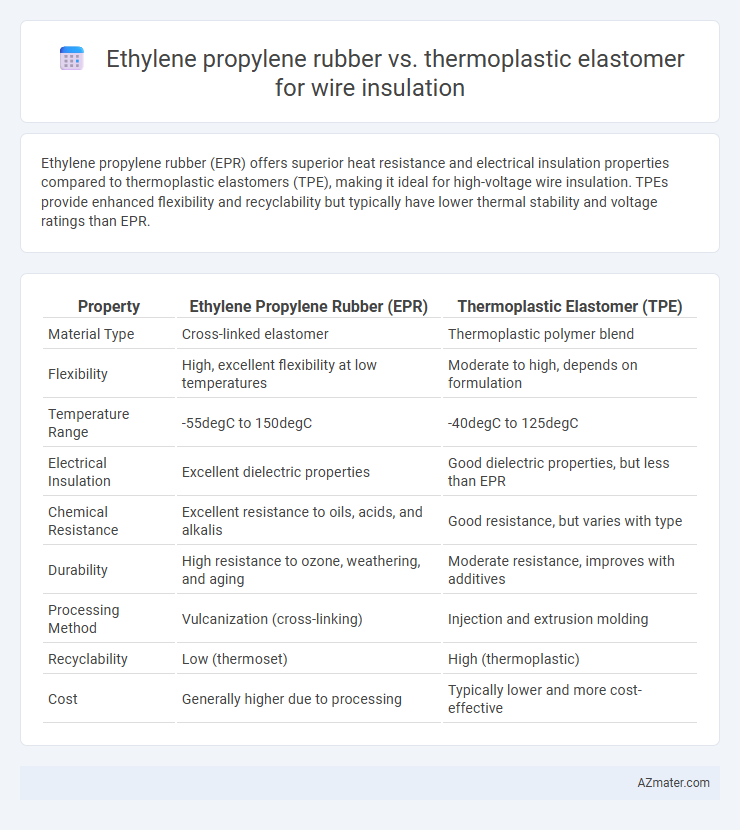Ethylene propylene rubber (EPR) offers superior heat resistance and electrical insulation properties compared to thermoplastic elastomers (TPE), making it ideal for high-voltage wire insulation. TPEs provide enhanced flexibility and recyclability but typically have lower thermal stability and voltage ratings than EPR.
Table of Comparison
| Property | Ethylene Propylene Rubber (EPR) | Thermoplastic Elastomer (TPE) |
|---|---|---|
| Material Type | Cross-linked elastomer | Thermoplastic polymer blend |
| Flexibility | High, excellent flexibility at low temperatures | Moderate to high, depends on formulation |
| Temperature Range | -55degC to 150degC | -40degC to 125degC |
| Electrical Insulation | Excellent dielectric properties | Good dielectric properties, but less than EPR |
| Chemical Resistance | Excellent resistance to oils, acids, and alkalis | Good resistance, but varies with type |
| Durability | High resistance to ozone, weathering, and aging | Moderate resistance, improves with additives |
| Processing Method | Vulcanization (cross-linking) | Injection and extrusion molding |
| Recyclability | Low (thermoset) | High (thermoplastic) |
| Cost | Generally higher due to processing | Typically lower and more cost-effective |
Understanding Ethylene Propylene Rubber (EPR)
Ethylene Propylene Rubber (EPR) offers excellent electrical insulation properties, high thermal stability, and superior resistance to weathering and ozone, making it ideal for wire insulation in harsh environments. Its non-polar structure provides low dielectric constant and loss, ensuring efficient current transmission while maintaining flexibility across a wide temperature range. Compared to Thermoplastic Elastomers (TPE), EPR delivers more robust chemical resistance and electrical performance, essential for high-voltage and outdoor cable applications.
Overview of Thermoplastic Elastomers (TPE)
Thermoplastic elastomers (TPE) combine the flexibility of rubber with the processability of plastics, making them ideal for wire insulation applications requiring durability and ease of manufacturing. Unlike Ethylene Propylene Rubber (EPR), TPE materials exhibit excellent resistance to environmental stress cracking, UV exposure, and chemical degradation, enhancing wire longevity in harsh conditions. Their recyclable nature and ability to be processed at lower temperatures contribute to cost-efficiency and sustainability in insulated wire production.
Key Material Properties: EPR vs TPE
Ethylene propylene rubber (EPR) offers superior electrical insulation due to its excellent dielectric strength and resistance to ozone, heat, and weathering, making it ideal for high-voltage wire insulation. Thermoplastic elastomers (TPE) provide greater flexibility and ease of processing with enhanced recyclability but generally exhibit lower thermal stability and electrical resistance compared to EPR. Optimizing wire insulation involves balancing EPR's durability and voltage resistance against TPE's mechanical flexibility and processing advantages.
Flexibility and Durability Comparison
Ethylene propylene rubber (EPR) exhibits superior flexibility with excellent elongation and elasticity, making it ideal for dynamic wire insulation applications requiring frequent bending. Thermoplastic elastomers (TPEs) provide enhanced durability through higher resistance to abrasion, environmental stress, and chemical exposure, ensuring long-lasting protection in harsh conditions. While EPR excels in flexibility and thermal stability, TPEs offer versatile processing and improved wear resistance, balancing performance for various wire insulation needs.
Electrical Performance in Wire Insulation
Ethylene propylene rubber (EPR) offers superior electrical insulation properties due to its excellent dielectric strength and high resistance to electrical stress, making it ideal for high-voltage wire insulation applications. Thermoplastic elastomers (TPEs) provide good flexibility and ease of processing but generally have lower dielectric breakdown strength compared to EPR, limiting their use in high-stress electrical environments. The choice between EPR and TPE for wire insulation largely depends on required electrical performance, with EPR favored for demanding electrical insulation and TPE used where flexibility and manufacturability are prioritized.
Temperature Resistance: EPR and TPE
Ethylene propylene rubber (EPR) offers excellent temperature resistance, typically withstanding continuous operating temperatures up to 130degC and short-term exposure up to 150degC, making it ideal for high-heat wire insulation applications. Thermoplastic elastomers (TPE), while versatile and easier to process, generally have lower thermal stability, with maximum service temperatures around 90degC to 125degC depending on the specific formulation. For wire insulation requiring superior heat resistance and long-term durability, EPR outperforms most TPE materials in maintaining electrical and mechanical properties under elevated temperature conditions.
Chemical and Environmental Resistance
Ethylene propylene rubber (EPR) exhibits superior resistance to ozone, heat, and various chemicals such as acids and alkalis, making it ideal for harsh environmental conditions in wire insulation. Thermoplastic elastomers (TPEs) offer good chemical resistance but generally underperform against prolonged exposure to oils and solvents compared to EPR. In terms of environmental resistance, EPR maintains flexibility and insulating properties in extreme temperatures and UV radiation, whereas TPEs may degrade faster under similar stressors.
Installation and Processing Differences
Ethylene propylene rubber (EPR) offers excellent flexibility and heat resistance, making it ideal for installation in environments requiring tight bends and prolonged exposure to high temperatures. Thermoplastic elastomers (TPE), with their ability to melt and reform, facilitate faster processing through extrusion and easier recycling but may lack the same thermal durability as EPR. EPR requires vulcanization during processing, resulting in a more robust insulation layer, while TPE benefits from simpler, solvent-free processing methods, enhancing manufacturing efficiency.
Cost Analysis: EPR vs TPE for Wire Insulation
Ethylene propylene rubber (EPR) typically offers a lower initial cost compared to thermoplastic elastomers (TPE) in wire insulation applications due to its simpler manufacturing process and raw material availability. EPR provides excellent electrical insulation and weather resistance, reducing long-term maintenance expenses despite higher upfront material costs in some scenarios. TPE, while often more expensive initially, offers easier recyclability and faster processing times that can lower overall production costs in high-volume manufacturing.
Application Suitability and Industry Standards
Ethylene propylene rubber (EPR) offers superior resistance to heat, ozone, and electrical stress, making it ideal for high-voltage wire insulation in power distribution and industrial applications adhering to IEEE and IEC standards. Thermoplastic elastomers (TPEs) provide enhanced flexibility, ease of processing, and recyclability, suited for automotive wiring and consumer electronics where UL and RoHS compliance are critical. Both materials must meet stringent flame retardancy and thermal stability requirements to ensure safety and performance across diverse electrical insulation applications.

Infographic: Ethylene propylene rubber vs Thermoplastic elastomer for Wire insulation
 azmater.com
azmater.com